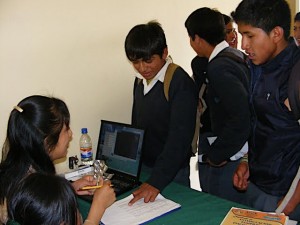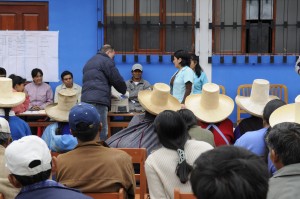Community Leadership to Prevent Intimate Partner Violence (fieldwork in progress)
As of 2022, 56 percent of women in Peru have experienced intimate partner violence (IPV), and 59 percent of the population shows tolerance towards violence against women. Addressing these challenges requires a comprehensive approach that includes shifting social attitudes, norms, and behaviors. In response, the Peruvian Ministry of Women and Vulnerable Populations (MIMP) developed its flagship program, Leaders in Action (LIA, or ICCLOS for its name in Spanish), to train local community leaders to conduct IPV prevention campaigns in rural Peru. LIA traditionally uses door-to-door visits, but this study tests several innovations, including village-level sessions, additional community leader involvement, and telenovela-style “edutainment”. A final evaluation will be completed by mid-2025 to assess the program’s impact on IPV, social norms, and women’s empowerment.
with Ursula Aldana, Javier Romero and Livia Schubiger
Is Community-based Targeting Effective in Identifying Intimate Partner Violence? with Jorge Aguero, Ursula Aldana, Veronica Frisancho and Javier Romero
Collaborating Organizations: Innovations for Poverty Action, Peru and Ministry of Women and Vulnerable Populations (MIMP)
Funding Organizations: IPA IPV; J-PAL GPI; J-PAL CVI; NIH; The World Bank
Engaging Men in Virtual Support Groups to Reduce Intimate Partner Violence
 Despite growing interest in engaging men in programs to reduce intimate partner violence (IPV), evidence is limited on what works to effectively enroll them and shift behavior. This study evaluated a novel IPV-prevention approach that used social media to recruit men in WhatsApp-based virtual support groups (VSGs) led by trained male facilitators. The approach successfully recruited men at high risk of committing IPV, with 52% of their female partners reporting IPV at baseline, significantly higher than the national average. The program led to a 20% reduction in sexual violence, with larger reductions among men with higher baseline risk. Group composition played a critical role, with men in groups of similar violence proclivity showing more significant behavior change. This study provides novel evidence on both positive and negative peer effects in behavior change programs, with implications for the optimal composition of group interventions. Our findings highlight that segregating individuals based on baseline risk appears to magnify program impacts on high-risk individuals – or those with the most to gain from the intervention – and hence the program impact overall.
Despite growing interest in engaging men in programs to reduce intimate partner violence (IPV), evidence is limited on what works to effectively enroll them and shift behavior. This study evaluated a novel IPV-prevention approach that used social media to recruit men in WhatsApp-based virtual support groups (VSGs) led by trained male facilitators. The approach successfully recruited men at high risk of committing IPV, with 52% of their female partners reporting IPV at baseline, significantly higher than the national average. The program led to a 20% reduction in sexual violence, with larger reductions among men with higher baseline risk. Group composition played a critical role, with men in groups of similar violence proclivity showing more significant behavior change. This study provides novel evidence on both positive and negative peer effects in behavior change programs, with implications for the optimal composition of group interventions. Our findings highlight that segregating individuals based on baseline risk appears to magnify program impacts on high-risk individuals – or those with the most to gain from the intervention – and hence the program impact overall.
with Christopher Boyer, Andrew Morrison and Claudia Piras
Collaborating Organizations: Inter-American Development Bank (IADB), IPA Peru and IRC Airbel Impact Lab
Funding Organizations: Inter-American Development Bank (IADB); USAID DIV

Iron Deficiency, Anemia and School Performance
The project goals are to measure the effect of iron pills and access to information and communication technology on educational outcomes of children in high-altitude rural Peru. Through a randomized design, the study varied both the encouragement and intensity of the treatments in order to tease out the mechanisms through which intervention uptake is highest.
Is there a Nutrient-Based Poverty Trap in Developing Countries? Iron Deficiency and Human Capital Attainment in Rural Peru
with Alberto Chong, Isabelle Cohen, Alberto Nakasone and Maximo Torero
Collaborating Organization: International Food Policy Research Institute (IFPRI)
Funding Organization: Inter-American Development Bank (IADB)
Land Titling
Property rights are often cited as a prerequisite for economic development, and in 1996, Peru issued over 1.2 million property titles to urban squatters, significantly enhancing property rights. Taking advantage of this initiative, this project studied the relationship between property rights and credit access, labor supply, crop choice, and fertility.
Entitled to Work: Urban Property Rights and Labor Supply in Peru
Do Property Titles Increase Credit Access Amongst the Urban Poor? Evidence from a Nationwide Titling Program
with Maximo Torero
Property Rights and Investments in Urban Slums
Globalization, Crop Choice and Property Rights in Rural Peru. 1994-2004
with Alfred J. Field
Fertility Responses to Land Titling: The Roles of Ownership Security and the Distribution of Household Assets (unpublished manuscript)
Collaborating Organizations: PETT and COFOPRI
Funding Organizations: USAID; Inter-American Development Bank (IADB); The World Bank
Mobile Clinics and Teacher Training to Reduce Teen Pregnancy (fieldwork in progress)
 Teenage pregnancy has adverse health effects on both mother and child. It also risks teenagers’ educational achievement and economic mobility, especially for vulnerable populations. While there is widespread recognition of the need to strengthen adolescent sexual education and pregnancy prevention services, there is limited evidence on effective interventions, particularly in resource-constrained settings. This project tests two approaches to improve sexual education for teenagers in Ayacucho, Peru. The first is a Mobile Clinic staffed by local reproductive health professionals that visits community high schools to deliver on-demand, individualized reproductive health guidance. The second is a four-month teacher training program to enhance the sexual education offered in high schools by equipping teachers with effective pedagogical tools. We evaluate the impact of these interventions on teenage birth rates, female school dropout, and academic performance.
Teenage pregnancy has adverse health effects on both mother and child. It also risks teenagers’ educational achievement and economic mobility, especially for vulnerable populations. While there is widespread recognition of the need to strengthen adolescent sexual education and pregnancy prevention services, there is limited evidence on effective interventions, particularly in resource-constrained settings. This project tests two approaches to improve sexual education for teenagers in Ayacucho, Peru. The first is a Mobile Clinic staffed by local reproductive health professionals that visits community high schools to deliver on-demand, individualized reproductive health guidance. The second is a four-month teacher training program to enhance the sexual education offered in high schools by equipping teachers with effective pedagogical tools. We evaluate the impact of these interventions on teenage birth rates, female school dropout, and academic performance.
with Renzo Severino
Collaborating Organizations: Asociación Kallpa and IPA Peru
Funding Organization: The Old Dart Foundation
